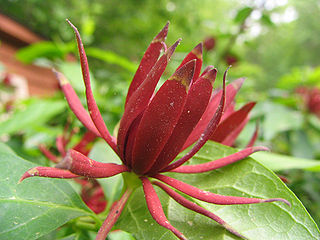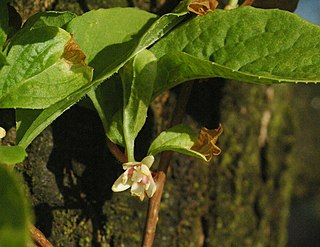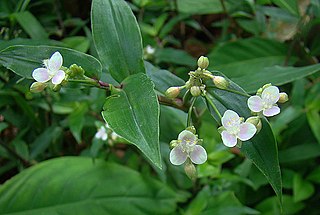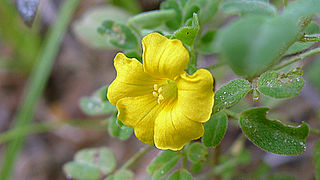
Commelinales is an order of flowering plants. It comprises five families: Commelinaceae, Haemodoraceae, Hanguanaceae, Philydraceae, and Pontederiaceae. All the families combined contain over 885 species in about 70 genera; the majority of species are in the Commelinaceae. Plants in the order share a number of synapomorphies that tie them together, such as a lack of mycorrhizal associations and tapetal raphides. Estimates differ as to when the Commelinales evolved, but most suggest an origin and diversification sometime during the mid- to late Cretaceous. Depending on the methods used, studies suggest a range of origin between 123 and 73 million years, with diversification occurring within the group 110 to 66 million years ago. The order's closest relatives are in the Zingiberales, which includes ginger, bananas, cardamom, and others.

The Poales are a large order of flowering plants in the monocotyledons, and includes families of plants such as the grasses, bromeliads, rushes and sedges. Sixteen plant families are currently recognized by botanists to be part of Poales.

Alstroemeriaceae is a family of flowering plants, with 254 known species in four genera, almost entirely native to the Americas, from Central America to southern South America. One species of Luzuriaga occurs in New Zealand, and the genus Drymophila is endemic to south-eastern Australia.

Nartheciaceae is a family of flowering plants. The APG III system places it in the order Dioscoreales, in the clade monocots. As circumscribed by APG IV (2016) it includes 35 species of herbaceous plants in the following five genera:

Xanthosoma is a genus of flowering plants in the arum family, Araceae. The genus is native to tropical America but widely cultivated and naturalized in other tropical regions. Several are grown for their starchy corms, an important food staple of tropical regions, known variously as malanga, otoy, otoe, cocoyam, tannia, tannier, yautía, macabo, ocumo, macal, taioba, dasheen, quequisque, ʻape and as Singapore taro. Many other species, including especially Xanthosoma roseum, are used as ornamental plants; in popular horticultural literature these species may be known as ‘ape due to resemblance to the true Polynesian ʻape, Alocasia macrorrhizos, or as elephant ear from visual resemblance of the leaf to an elephant's ear. Sometimes the latter name is also applied to members in the closely related genera Caladium, Colocasia (taro), and Alocasia.

The Calycanthaceae are a small family of flowering plants in the order Laurales. The family contains three genera and only 10 known species, restricted to warm temperate and tropical regions:

Illiciaceae A.C.Sm. was a family of flowering plants recognized in a number of systems of plant taxonomy. The Illiciaceae is not recognized as a distinct family by the APG III system of plant taxonomy, the most well accepted system in use today.

Schisandraceae is a family of flowering plants with 3 known genera and a total of 92 known species. Such a family has been recognized by most taxonomists, at least for the past several decades. Before that, the plants concerned were assigned to family Magnoliaceae and Illiciaceae.

Peridiscaceae is a family of flowering plants in the order Saxifragales. Four genera comprise this family: Medusandra, Soyauxia, Peridiscus, and Whittonia., with a total of 12 known species. It has a disjunct distribution, with Peridiscus occurring in Venezuela and northern Brazil, Whittonia in Guyana, Medusandra in Cameroon, and Soyauxia in tropical West Africa. Whittonia is possibly extinct, being known from only one specimen collected below Kaieteur Falls in Guyana. In 2006, archeologists attempted to rediscover it, however, it proved unsuccessful.

The Marcgraviaceae are a neotropical angiosperm family in the order Ericales. The members of the family are shrubs, woody epiphytes, and lianas, with alternate, pinnately nerved leaves. The flowers are arranged in racemes. The flowers are accompanied by modified, fleshy, saccate bracts which produce nectar. The flowers are pentamerous. The fruits are capsules.

Najas, the water-nymphs or naiads, is a genus of aquatic plants. It is cosmopolitan in distribution, first described for modern science by Linnaeus in 1753. Until 1997, it was rarely placed in the Hydrocharitaceae, and was often taken as constituting the family Najadaceae.

Schoepfiaceae is a family of flowering plants recognized in the APG III system of 2009. The family was previously only recognized by few taxonomists; the plants in question usually being assigned to family Olacaceae and Santalaceae.

Aegiphila is a genus of flowering plants in the mint family, Lamiaceae, first described in 1763. It was formerly classified in the Verbenaceae. It is native to Mexico, Central America, South America, the West Indies, and Florida.

Brunellia is a genus of trees. They are distributed in the mountainous regions of southern Mexico, Central America, West Indies, and South America. Brunellia is the only genus in the family Brunelliaceae. As of 2001 there were about 54 species.

Syngonanthus is a genus of flowering plants in the family Eriocaulaceae. It is native to tropical Africa and to Latin America.

Callisia is a genus of flowering plants in the spiderwort family, Commelinaceae. Members of the genus are commonly known as roselings. It is native to the Western Hemisphere from the southern United States to Argentina. The generic name is derived from the Greek word κάλλος (kallos), meaning "beauty."

Homolepis is a genus of Neotropical plants in the grass family. They are native to Mexico, Central and South America, and the West Indies.

Tripogandra is a genus of flowering plants in the spiderwort family, Commelinaceae. It is native to the Western Hemisphere from central Mexico and the West Indies south to Argentina.
Dendrobangia is a genus of flowering plants in the family Metteniusaceae. It was formerly placed in the family Cardiopteridaceae. It was described as a genus in 1896.

Oxalis frutescens, the shrubby woodsorrel, is a species of flowering plant in the family Oxalidaceae. It is native to New Mexico, Texas, Mexico, Central America, the southernmost Caribbean islands, and tropical South America as far as northern Argentina. A perennial subshrub reaching 35 cm (14 in), it is typically found in sandy soils in grasslands, pastures, roadsides, and open oak woodlands.



















